Irish women activists and the struggle for Indian independence
Published in 20th-century / Contemporary History, Features, Issue 2 (March/April 2018), Volume 26In the year when we celebrate the 100th anniversary of the parliamentary vote for women, a look at the later lives of some of the women involved and their support for Indian independence—Maud Gonne MacBride, Charlotte Despard and Mollie Woods.
By Kate O’Malley
Maud Gonne
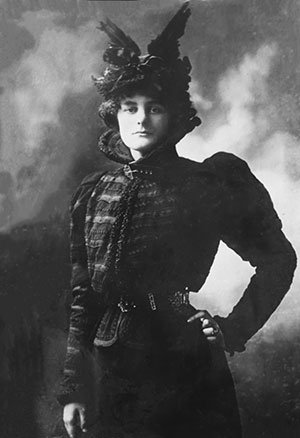
Above: Maud Gonne MacBride—made contact in the early 1900s with a loose network of Indian activists in Paris, which would be the basis for the formation of the Indian Irish Independence League some twenty years later.
This Irish nationalist/feminist icon needs little introduction, but what are perhaps less well known are her early contacts with Indian activists in Paris. In the wake of the extensive publicity that followed her filing for divorce from John MacBride and with her popularity waning, she began to spend much of her time in France. When her divorce appeal failed in 1908, and as her marriage separation verdict was deemed valid only in France, she moved there on a more permanent basis in order to retain custody of her son, Seán. The Indian nationalists with whom she liaised in Paris included Sarat Chandra Bose, Madam Cama, Sardar Singh Rana and Shyamji Krishna Verma. Cama was a woman who had a lot in common with Maud Gonne MacBride, a tireless political activist who set up and edited nationalist journals in Paris and Berlin. She had arrived in London in 1901 and, just as Gonne MacBride’s time working with evicted families in Donegal and Irish political prisoners in the 1890s had been a turning point in her life, Cama’s experiences in Bombay during the plague epidemic of 1897 had made her bitterly anti-British. Owing to increased surveillance by the British authorities, Krishna Verma, the famed founder of India House in London, relocated to Paris in 1907, with Cama following suit in 1909. While in Paris, Cama was smuggling revolutionary literature and explosives into India. Gonne MacBride had already made contact with these heavyweight activists while in London, as her close friend Charlotte Despard had been at the opening of India House in July 1905. At any rate, Paris in the early 1900s was the backdrop for the establishment of a loose network of anti-British Indian and Irish agitators, and this would be the basis for the formation of the Indian Irish Independence League some twenty years later.
Charlotte Despard
Born Charlotte French, she married Maximilian Despard, a wealthy Anglo-Irish businessman, in 1879. Ten years after his death she began to devote herself to charitable work and became a Poor Law guardian for Lambeth. Over time, however, she became a long-suffering political activist and social reformer, a path she followed despite her aristocratic background. The breadth of her political activities is astonishing. She was involved in the campaign for the abolition of the workhouse, in the fight for women’s suffrage, in the resistance to conscription and the crusade for a negotiated peace after the outbreak of the First World War, and in the battles for Irish and Indian independence; finally, towards the end of her life, she became an ardent left-wing socialist and, eventually, a communist. Despard was the daughter of a Royal Naval officer, born and raised in Kent, although the family was of Irish descent. Her later membership of Sinn Féin and her relocation to Dublin in 1921 were to be a cause of much embarrassment to her family—her brother, Field Marshal Lord French, had been sworn in at Dublin Castle in May 1918 as lord lieutenant of Ireland. Her main associate in Dublin was fellow activist Maud Gonne MacBride. The two were close friends and lived together for some years in Roebuck House before Despard purchased a home in Eccles Street in the 1930s. In the wake of a visit to Russia in 1931 she joined the Revolutionary Workers’ Group, which became the Communist Party of Ireland in 1933.
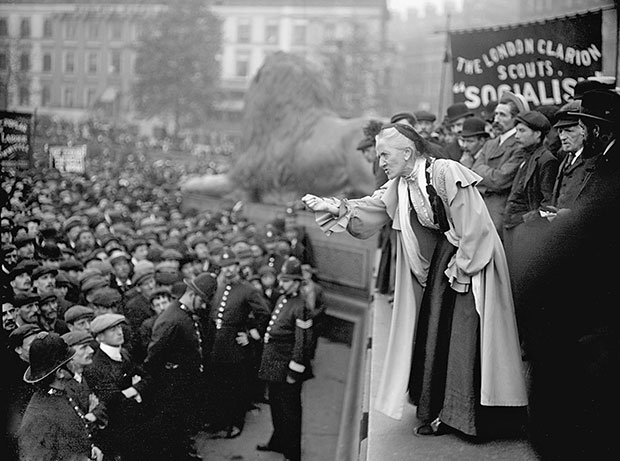
Above: Charlotte Despard addressing a rally in London’s Trafalgar Square c. 1910.
Mollie Woods
By the late 1920s, Gonne MacBride was working in Dublin with another political activist who had Indian contacts, Mary (Mollie) Woods, originally from County Sligo. Her son Tony served as staff captain in the IRA, was on the anti-Treaty side in the Civil War and in the Four Courts in June 1922. Her husband was Andrew Woods, an Ancient Order of Hibernians man and a friend of Arthur Griffith’s. The family settled at 131 Morehampton Road, Dublin, around the corner from the O’Rahillys. Woods was a great friend of many IRA members at the time, and she was privy to much that was going on in the revolutionary movement. At one stage during the War of Independence she was actively working for Michael Collins and purchased on his behalf a number of safe houses, while her home on Morehampton Road was a well-known safe house. Peadar O’Donnell recounted how, upon his escape from jail in 1923, he lay concealed between the rafters and slates in a dark corner of the Woods’ attic as a raiding party passed through the skylight. Much later on and nearing his death, Ernie O’Malley stayed with the family and was well regarded and admired by them all. The Woods family, with their staunch nationalist and anti-Treaty background, became involved in the left-wing republican movement in the years after the Civil War, especially Mollie, who was a prominent member of the Women’s Prisoners’ Defence League. But she was also drawn to the anti-imperialist debate that raged throughout Europe in the aftermath of the First World War and in the wake of the Bolshevik revolution. This was an interest that flourished as a result of the many Indian connections she made during these years. Indeed, her daughter Eileen married an Indian medical student, Tripura Charan Dey.
The Indian Irish Independence League
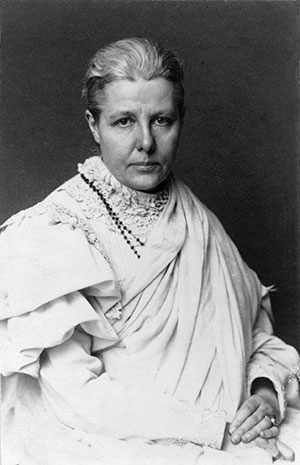
Above: Annie Besant—perhaps better known in India than in Ireland, she was a socialist and women’s rights campaigner who became a theosophist and travelled to India in 1898. She joined the Indian National Congress and was a founder of the Indian Home Rule League in 1914.
Throughout the spring of 1932 Charlotte Despard and her Indian associates in London were making preparations for V.J. Patel’s visit to Ireland that summer. Patel and his associate I.K. Yajnik were both influential Indian activists. They were cohorts of Gandhi’s, from his home state of Gujarat. Patel was a founding member of the Swaraj (‘self-rule’) Party and became president of the Indian Legislative Assembly in 1925. His younger brother, Sardar Patel, would outlive him and become deputy prime minister after Indian independence. Yajnik had spent time imprisoned alongside Gandhi in Yerwada Jail in the early 1920s and had helped him to write an early autobiography by dictation. After his release Yajnik spent several years in the 1920s and 1930s in Europe pursuing a propaganda campaign for Indian independence. Interestingly, both Patel and Yajnik had learned about Ireland from two other Irish women based in India: Annie Besant and Margaret Cousins. Yajnik had been inspired to join the Indian home rule movement in 1917 after reading the work of Annie Besant while still a student. Besant, perhaps better known in India than in Ireland, was a socialist and women’s rights campaigner who became involved in Indian politics after becoming a theosophist and travelling to India in 1898. She joined the Indian National Congress and was a founder of the Indian Home Rule League in 1914. London-born, of Anglo-Irish stock, throughout her life Besant was inclined to emphasise her Irish origins and was a supporter of Irish independence. In the wake of the 1916 Rising, however, the government of India was particularly concerned with restricting what it termed more ‘seditious’ activity by the likes of Besant and her colleagues, and this resulted in one of the editors of her New India newspaper having to step down, fellow theosophist James Cousins. He had written a series of pieces in May 1916 eulogising Patrick Pearse, James Connolly and the other Easter leaders, and he blamed the British imperial ‘ruling caste’ for the rebellion. Yajnik and V.J. Patel had both encountered James Cousins’s wife Margaret in India, a woman better known in an Irish context as a suffragette. The Cousins moved to India the year before the Rising in 1915, but Margaret had stayed in touch with some of her colleagues, most notably Charlotte Despard and Hanna Sheehy-Skeffington.
Patel had been to Ireland twice before, but de Valera’s recent general election success contributed to a renewed fervour and clamour on the part of radical nationalists in both London and Dublin to have Patel visit Ireland again. Patel and Yajnik arrived in Dublin late in the evening of 2 July 1932. Their first public venture was the following day, when they attended the unveiling of the Markievicz memorial by de Valera in St Stephen’s Green. Patel was described in the press as ‘a striking and picturesque figure in white’, who ‘on being introduced to the gathering received a rousing welcome’. On the evening of 8 July 1932 Patel attended a public meeting in College Green. The Irish Press estimated attendance at around 3,000 and reported that ‘the Indian Nationalist leader … was the central figure … loud cheers rang out as soon as [he] was recognised’. A crucial behind-the-scenes aspect of Patel’s stay in Dublin was making arrangements for the foundation of the Indian–Irish solidarity movement, and this he did with Gonne MacBride, Despard and Woods late at night, in Gonne MacBride’s St Stephen’s Green residence. After some preliminary discussions it was resolved to inaugurate the Indian Irish Independence League (IIIL), which would ‘work by every possible means to secure the complete independence of India and Ireland, and to achieve the closest solidarity between the Irish and the Indian masses in their common struggle against British imperialism’.
It seems that Maud Gonne MacBride was anxious that a lack of resident or prominent Indian members would hinder the progress of the organisation or, at the very least, affect its credibility. In order to prevent such developments, Patel decided to send Yajnik over from London on a more permanent basis and he became a special Indian contributor to An Phoblacht. By October, with Yajnik’s involvement, the IIIL’s constitution had been amended, finalised and published. The object of the League was ‘to help by every means possible to secure the complete national, social and economic independence of the people of India and Ireland’, and there followed a list of methods that should be adhered to in order to fulfil that objective. The first two declared methods were:
(1) organising in Ireland and wherever else possible a complete boycott of British goods and concerns;
(2) establishing an Indian information bureau to spread the truth about the Indian struggle, and to counteract imperial lies generally.
In the wake of Patel’s visit these two initial aims had been successfully followed through. There was increased coverage of the Indian situation in An Phoblacht thanks to the formation of the League and to Yajnik’s and Peadar O’Donnell’s collaboration. Cooperation with Irish republicans involved with the League saw other Indian nationalist journalists, such as Pulin Behari Seal and Ray Chowdhury, find an outlet for their anti-imperialist writings. Campaigns to boycott British goods had been instigated in Ireland at various stages since the War of Independence, and these were revived with gusto after the onset of the economic war. But arguably it was the League’s initiative in publicising the immensely successful Indian boycott campaign, ‘the swadeshi [self-sufficiency] movement’, that provided renewed vigour for the Irish version. It was a ploy that had the added benefit of attracting people of non-socialist, non-republican backgrounds who would be motivated less by partisan domestic politics and more by altruistic, if essentially anti-imperialist, principles. Patel had continued correspondence with Mollie Woods in her capacity as the secretary of the IIIL right up until his death in 1933. The League’s most momentous task came some three years later when it organised the famous Indian nationalist leader Subhas Chandra Bose’s much-publicised visit to Dublin in February 1936.
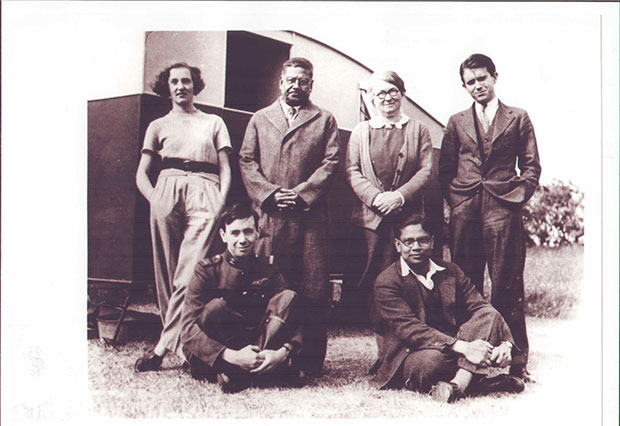
Above: Members of the Woods and Dey families c. 1930s—(back, left to right) Ellen Woods, H.L. Dey, Mollie Woods, founder of the Indian Irish Independence League, Enda Woods and (seated, left to right) Andy Woods and medical student Tripura Charan Dey, son of H.L. Dey and husband of Ellen Woods. (Lal Wright, née Dey)
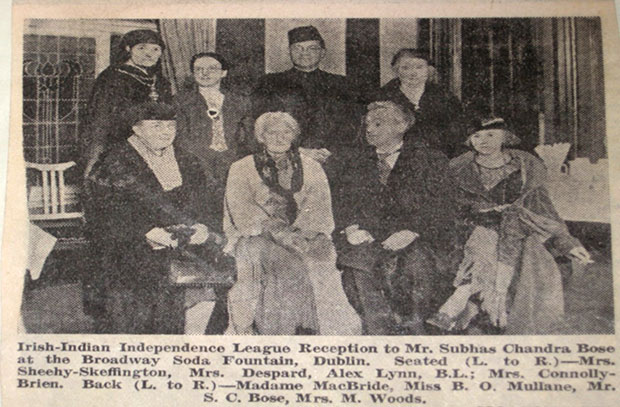
Above: At an Indian Irish Independence League reception to honour the visit of Subhas Chandra Bose to Ireland in February 1936—(back, left to right) Maud Gonne MacBride, Miss B.O. Mullane, Bose, Mollie Woods and (seated, left to right) Hanna Sheehy-Skeffington, Charlotte Despard, Alex Lynn BL and Mrs Connolly-O’Brien.
Dissolution
The Indian Irish Independence League was formally dissolved in 1945; the organisation’s funds, amounting to £98, were presented to the Cambridge University Indian Society by Maud Gonne MacBride. In a letter to Subrata Ray Chaudhury of the Society, Gonne MacBride stated that the object of the donation was to assist them in their campaign for Indian self-government. She had wound up the IIIL as she believed that ‘it could serve little useful purpose in Éire as an overwhelming majority of the people in the country strongly supported India’s demand for freedom’.
The story of the IIIL provides evidence of some overlooked themes not only in the lives of Irish revolutionary women but also in the ways and means by which the decolonisation process gained momentum in the inter-war period in the colonies themselves. The Irish Revolution was significant within the wider context of British decolonisation, not just in India but also in places like Egypt and Indonesia. Many of the leading figures of India’s nationalist movement in particular, however, looked to Ireland for inspiration in the years after the 1916 Rising. That such a small country so close to the heart of the British Empire was successful in gaining freedom from their common enemy greatly ignited Indian nationalists’ imaginations. But Irish imaginations were ignited too; there was an immense appetite for Indian politics in 1930s Ireland, and these women played no small part in feeding this hunger.
Kate O’Malley is editor of the Royal Irish Academy’s Documents on Irish Foreign Policy (DIFP) series.
FURTHER READING
Mulvihill, Charlotte Despard: a biography (London, 1989).
O’Malley, Ireland, India and empire (Manchester, 2009).
Silvestri, Ireland and India. Nationalism, empire and memory (Cambridge, 2009).
Steele, Maud Gonne’s Irish nationalist writings 1895–1946 (Dublin, 2003).
















